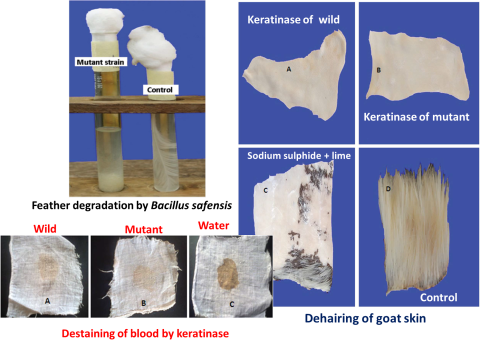Bacillus safensis LAU 13 as a new source of keratinase
In 2015, for the first time, we reported a keratinolytic strain of Bacillus safensis as follows:
A newly isolated bacterium identified as Bacillus safensis based on biochemical tests and 16S rRNA analysis and its mutant variant created by exposure to ultraviolet radiation at 254 nm were investigated for keratinolytic activity. The wild-type strain produced 35.4–50.4 U/mL keratinase over a period of 120 h, while the mutant one yielded 64.4–108.5 U/mL keratinase for the same period of 120 h. The optimal conditions for the enzyme activities were pH 7.5 and 40 °C. The mutant and wild-type strain keratinases retained 59% and 54% of their activity after 12 h pretreatment at 40 °C, and 64% and 60% of their activity after 12 h at pH 7.5, respectively. The keratinases showed high substrate specificity for feathers, but low specificity for human and bovine hairs. The enzymes were activated by Na+, Ca2+, Fe2+ and Mg2+. However, while Mn2+ activated the enzyme from the mutant strain, it inhibited that of the wild type. The mutant and wild-type strain completely degraded whole chicken feathers after 6 and 9 days at 30 ± 2 °C, and also completely dehaired goat skin within 12 and 16 h, respectively, without damage to the skin. Similarly, remarkable destaining of blood-stained cloth occurred within 2–3 h. The obtained results showed an improvement in the properties of the mutant strain for use of the micro-organism or its enzyme as biocatalysts.
Published in Biotechnology and Biotechnological Equipment: Link

